🦠 COVID-19 | Societal responsibility and hopefully government leadership
📊 Daily Data Brief: July 02, 2020, 08:02 GMT (❗️June 29, 2020, 08:37 GMT)
Cumulative case: 10,819,762 (+551,941) cumulative cases
Active cases: 4,260,152 (+69,410) (this is the number of currently infected patients)
Total Deaths: 519,272 (+14,653)
Serious/Critical Cases: 57,941 (+595)
Recovered: 6,040,338 (+477,281)
Source: Worldometers
1) Seven-day rolling average of new deaths(ECDC data)
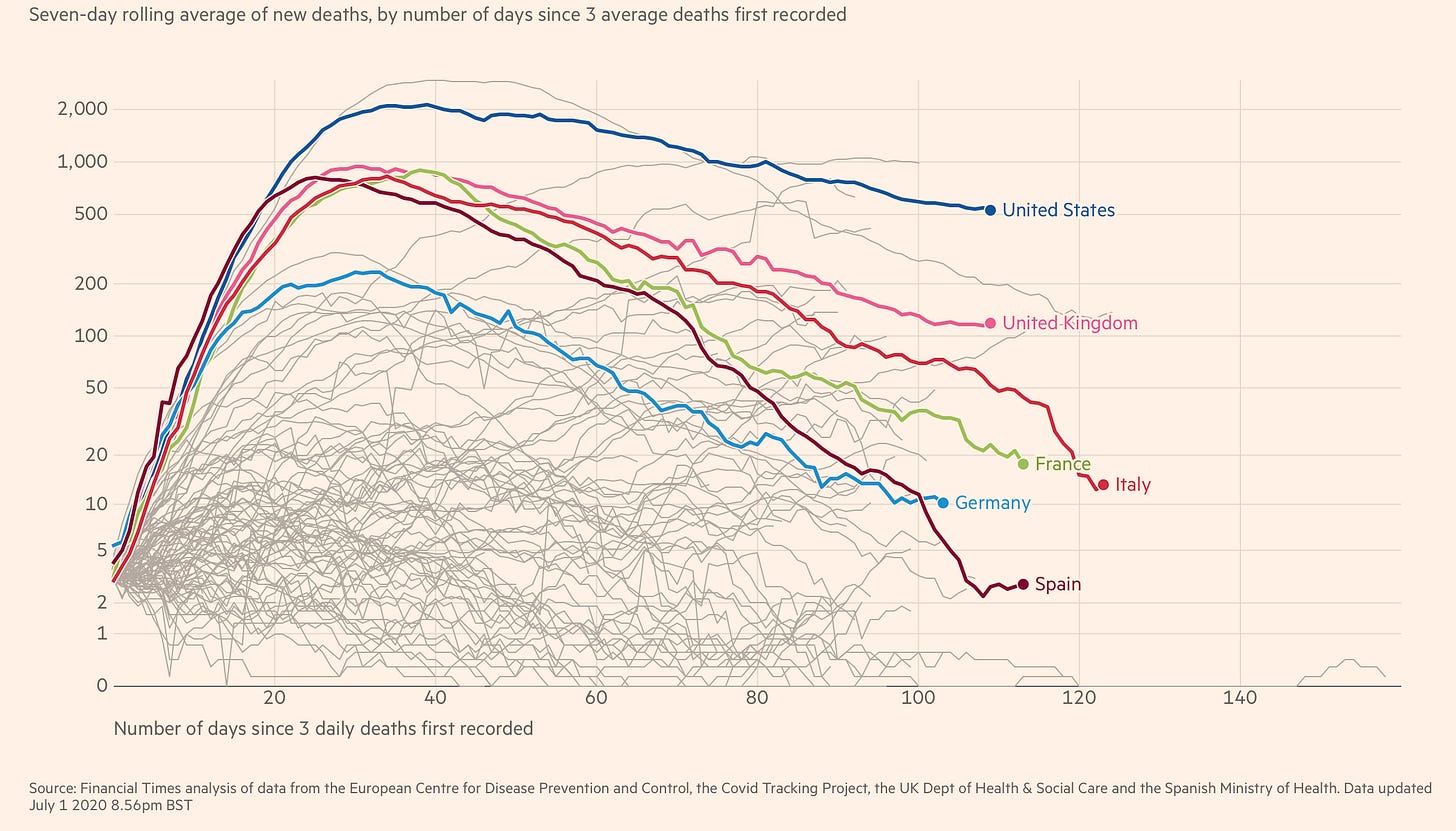
Showing a chart from the FT today highlighting the worrying situation in Brazil, Mexico, India and Russia and Iran (NEW❗️). Also the FT comparative charts now allow up to 6 countries.
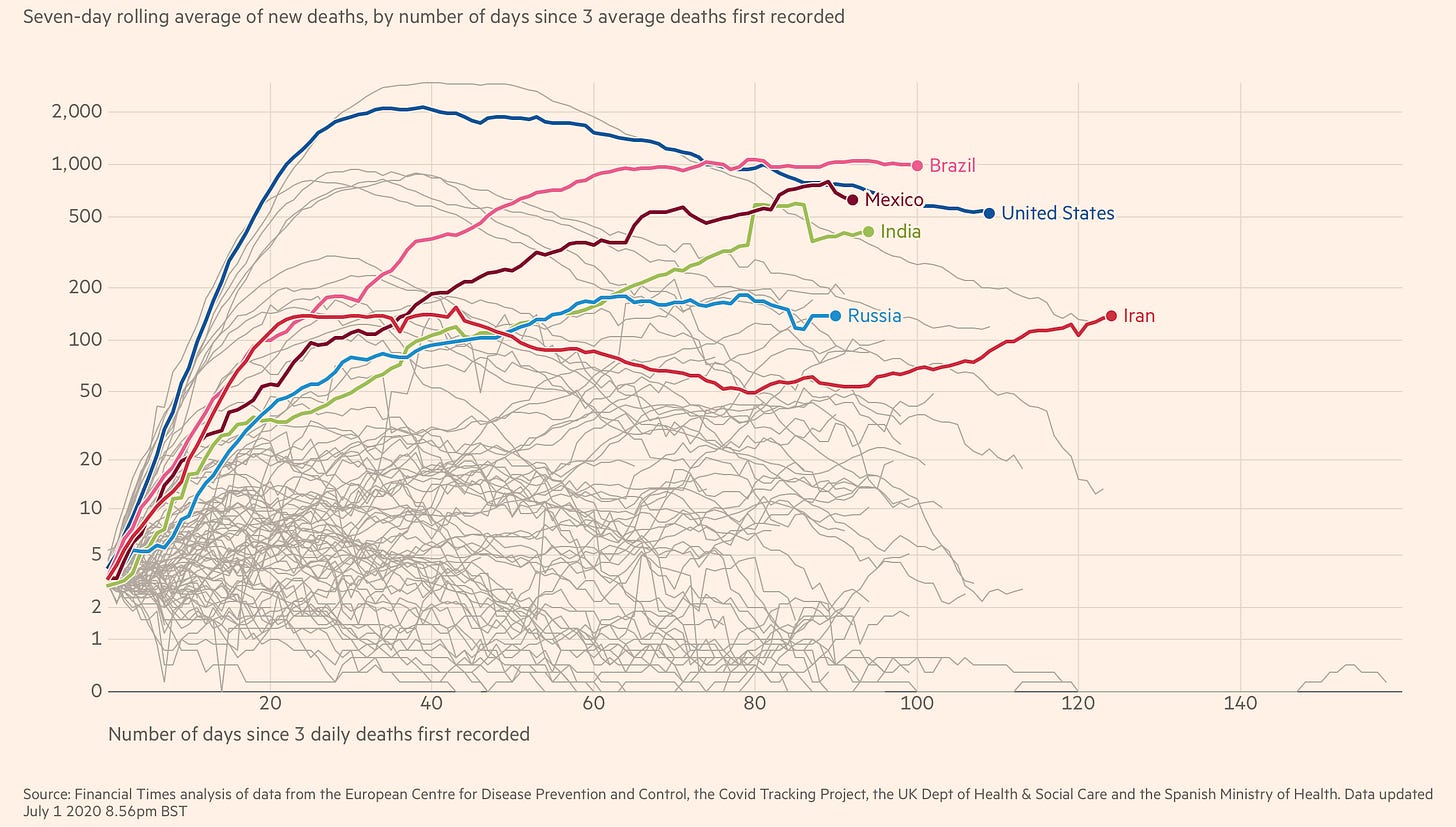
2) Rt estimate per State (US) (NEW❗️changed to RT.live which offers better visualisation of States above whose Rt>1 ).
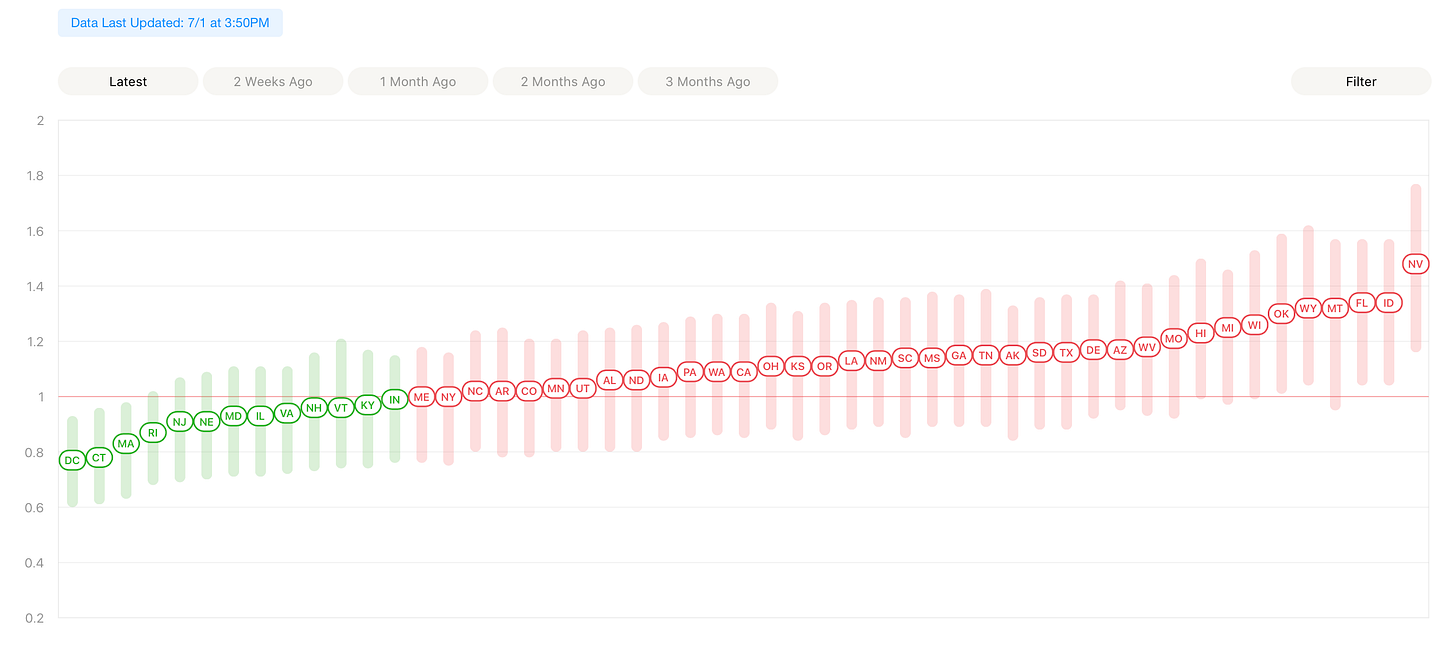
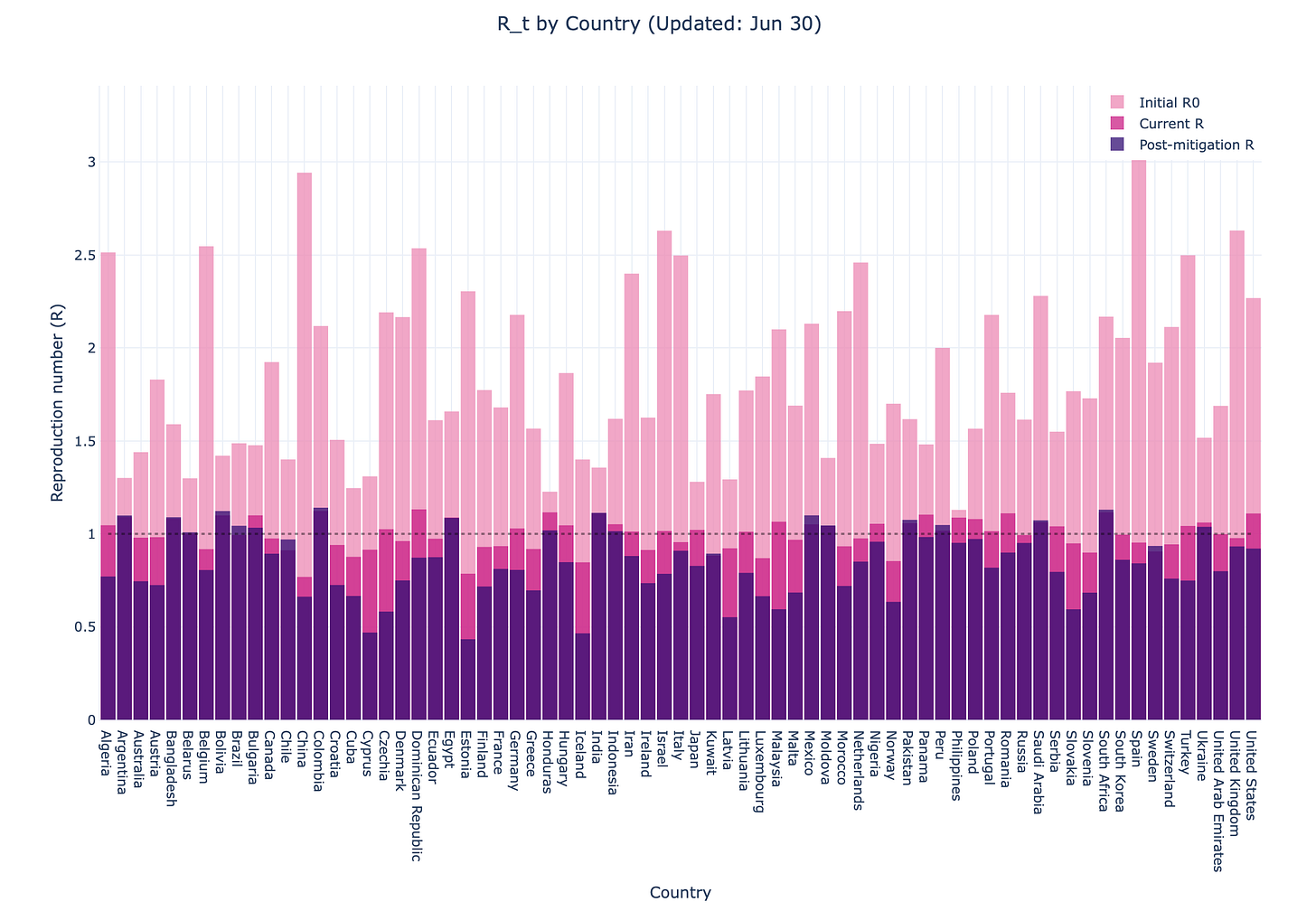
In this edition, I emphasise the importance of societal responsibility (video of the day and an article on California) particularly for my American friends where politicisation runs high in an election year. The measures to combat the virus are known and have worked in Europe (tweet of the day). Some of the endemic inequities in the US around health might make it more difficult to achieve as good a result there, but being a responsible individual cannot be postponed. A national mask mandate might be the quickest and less costly route to aid containment in the US as reported by Goldman Sachs below.
Two great threads on immunity and in particular the possible important role of T-Cell-mediated immunity to SARS-CoV-2 and one on this sensational G4 swine flu risk claim.
One article on lack of female expert voices in the media on COVID-19. A hopeful news on Pfizer vaccine candidate as they publish their results in a pre-print (as opposed through PR only).
A pre-print on seroconversion in New York City: high but far from herd immunity.
Testing capacity is strained in the US and that is very bad news.
A podcast on masks and other ways to stop the transmission with its accompanying insights article.
😷 Video of the day: Dr Fauci (Director of National Institute of Allergy and Infectious Diseases), on the protean nature of SARS-CoV-2 and the ‘societal responsibility’ of each of us in fighting this epidemic.
Fauci urges everyone to take part in containing the pandemic by their individual actions, regardless of the quality of the federal or regional leadership. This is particularly important in the United States, where a lot of Americans are quick to blame their current president in an election year, without maybe doing the most of what they can do at an individual level.
The temptation is great to politicise the response, but 1) we now know what works from success in other countries, 2) the virus does not know who is in the White House. (Link)


🇺🇸 vs 🇪🇺 Tweet of the day: Max Roser (founder of World in Data) tweets his weekly update chart of the new daily confirmed cases in the US and the EU.
China has had a totalitarian and surveillance approach in its response, but the EU who has had a mandated lockdown has also had a very different trajectory in its epidemic from the US.
If for cultural or political reasons, Americans are more attached to their liberty, it can also be done as long as they show greater ‘societal responsibility’.

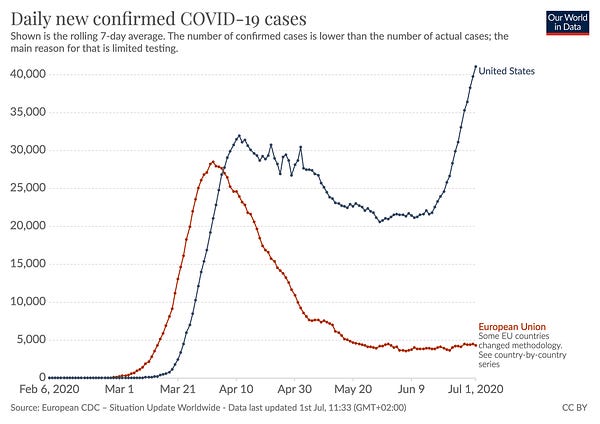
Threads of the day:
🦠 Thread of the day 1: “An explainer on SARS-CoV-2 immunity” by Francois Balloux (Director At UCL Genetics Institute ). (Link)
Balloux does a super job at distilling complex ideas on immunity and what we have learned thus far on immunity to SARS-CoV-2 ranging from innate immunity to acquired immunity (whether ‘antibody mediated’ or ‘T-Cell-mediated’).
It is helpful and particularly relevant now, as little has been published on T-Cell-Mediated immunity since the excellent paper from Shane Crotty featured in a previous edition of the Corona Daily mid-May (“Targets of T Cell Responses to SARS-CoV-2 Coronavirus in Humans with COVID-19 Disease and Unexposed Individuals”).
T-Cell-mediated immunity for SARS-CoV-2 has also been on the radar of Professor Karol Sikora (Oncologist):

There are two pre-prints (not peer reviewed) which emerged in the last week discussing the potential importance of T cells.
The first one (“Robust T cell immunity in convalescent individuals with asymptomatic or mild COVID-19”) was tweeted by Sikora.

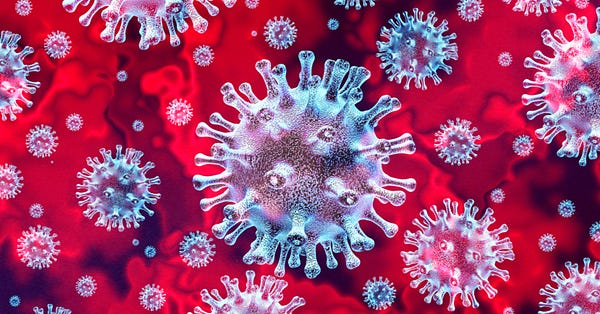
The second one was tweeted by Balloux:


Both of these papers continue to explore one hypothesis with potential important ramification about population immunity to SARS-CoV-2 stemming from prior exposure to common cold virus (from other coronavirus). Two noteworthy characteristics of T-Cell-mediated immunity response: typically longer memory and slower immune response. Why is it potentially significant, another good summary by Balloux:


I would also add a recent pre-print showing potential T-Cell based immunity without presence of seroconversion (production of antibodies)
🐷 Thread of the day 2: “About this G4 swine flu virus” a thread by Carl T Bergstrom (Biology Professor at University of Washington) (Link)
There were scary and viral headlines about a swine flu virus which could potentially cause another pandemic. A number of prominent scientists were quick to quell the fears and reassure people away from the clickbait headline.
Bergstrom did a stellar job of it, highlighting a noteworthy comment from Dr Fauci embedded in the article:


‘Why you shouldn't panic about the swine flu strain with 'pandemic potential’ is also an excellent article by Jackson Ryan for CNET which also references this thread and that of virologist Angela Rasmussen. Ryan also explains the potential motivation for having these misleading and viral headlines appear.
In doing so, it echoes some of the broader and related points which Justin Fox made in an excellent article in Bloomberg “Covid-19 Shows That Scientific Journals Need to Open Up”. In it Fox discusses the potential effect of over relying on metrics:
“Too heavy a reliance on performance metrics of any kind can shortchange creativity, innovation and other hard-to-measure things. The reliance on citation metrics in particular appears to discourage researchers from publishing negative or inconclusive results, producing an increasingly skewed picture of scientific knowledge and possibly encouraging scientific fraud.”
Rather than having science publishing move more and more towards the viral nature of news (and its disinformation plague), we should look at how we can improve it and make news move more towards the integrity and quality which the scientific community has been able to achieve.
💉 Derek Lowe writes “Pfizer and BioNTech’s First Vaccine Candidate” in his blog for Science ‘In the pipeline’. (Link). There is also and it has been welcome the first pre-print on an mRNA based-vaccine for COVID-19.
A clear and optimistic outlook for this vaccine candidate well summarised in the last paragraph:
“But back to these latest results: I agree with the paper’s conclusion, which says that its findings “are encouraging and strongly support accelerated clinical development and at-risk manufacturing“. So far, so good, and remember, these folks have three more mRNA vaccines coming along simultaneously. I very much await Moderna’s paper on their Phase I mRNA results for comparison – it’s been six weeks since the press release, guys, an eternity in Covid-time. Bring on the data, everyone!”
👩⚕️ Teresa Carr writes “In COVID-19 coverage, female experts are missing” for the Nieman Lab.
“By having these very loud, usually male, voices in the media touting expertise when they don’t have it, that risks undermining the public trust in science itself.”
A great article on the under-representation of expert women in the media coverage of COVID-19.
(Link)
🧪Alexis madrigal and Robinson Meyer write “A Dire Warning From COVID-19 Test Providers” in The Atlantic.
As US passed 50,000 detected daily cases for the first time yesterday, and Fauci and others warn that we could pass 100,000 cases, it stresses the testing capacity in the US, delays the time to results of to 3 to 5 days, therefore increasing the risk that infected patients silently spread the virus in the meantime. Worrying. (Link)
😷 Christopher Ingraham writes “National mask mandate could save 5 percent of GDP, economists say” in the Washington Post.
Ingraham reports on a recent Goldman Sachs reports which advocates in favour of a national mask mandate - a much less GDP costly measure than a second lockdown:
“A face mask mandate could potentially substitute for lockdowns that would otherwise subtract nearly 5% from GDP,” the team, led by the investment bank’s chief economist, Jan Hatzius, writes.”
(Link)
🍏 Daniel Stadlbauer et al. publish the pre-print “Seroconversion of a city: Longitudinal monitoring of SARS-CoV-2 seroprevalence in New York City” in MedRxiv.
A well run study of seroprevalence in New York City:
“By the week ending April 19, the seroprevalence in the screening group reached 19.3%, which is well below the estimated 67% needed to achieve community immunity to SARS-CoV-2.”
(Link)
🇺🇸 James Temple writes ‘There’s not one reason California’s covid-19 cases are soaring—there are many” for the MIT Technology review.
As the California governor re-imposes stricter shutdown rules, Temple reminds us that fighting this virus is not only about the policy but also about prevalent health inequities and because “People are becoming cavalier” echoing the societal responsibility emphasis of Dr. Fauci.
(Link)
🎙 😷 “Stopping the spread of COVID-19 with masks” the Science Podcast (12 min 30 sec)(Link)
“Kimberly Prather, an atmospheric chemist at the University of California, San Diego, who studies how ocean waves disperse virus-laden aerosols, joins host Sarah Crespi to talk about how she became an outspoken advocate for using masks to prevent coronavirus transmission.”
“Reducing transmission of SARS-CoV-2” is also the ‘Insights’ which Prather wrote and discusses in the podcast.



